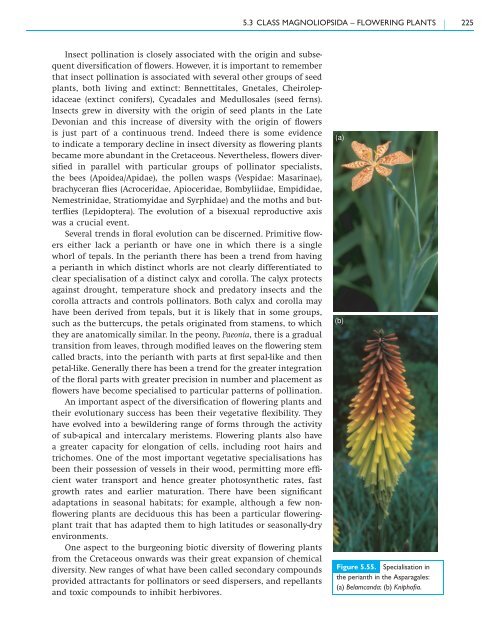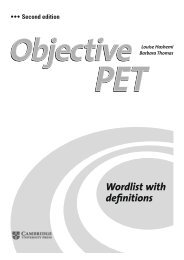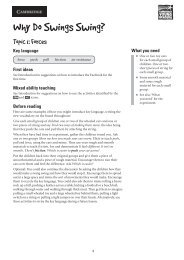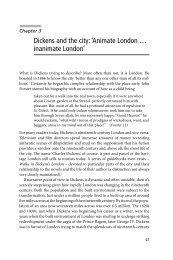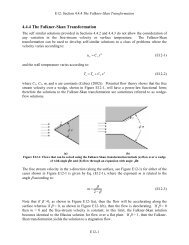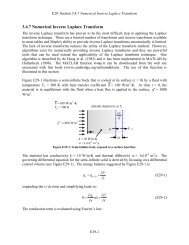5.3 Class Magnoliopsida – flowering plants - Cambridge University ...
5.3 Class Magnoliopsida – flowering plants - Cambridge University ...
5.3 Class Magnoliopsida – flowering plants - Cambridge University ...
Create successful ePaper yourself
Turn your PDF publications into a flip-book with our unique Google optimized e-Paper software.
Insect pollination is closely associated with the origin and subsequent<br />
diversification of flowers. However, it is important to remember<br />
that insect pollination is associated with several other groups of seed<br />
<strong>plants</strong>, both living and extinct: Bennettitales, Gnetales, Cheirolepidaceae<br />
(extinct conifers), Cycadales and Medullosales (seed ferns).<br />
Insects grew in diversity with the origin of seed <strong>plants</strong> in the Late<br />
Devonian and this increase of diversity with the origin of flowers<br />
is just part of a continuous trend. Indeed there is some evidence<br />
to indicate a temporary decline in insect diversity as <strong>flowering</strong> <strong>plants</strong><br />
became more abundant in the Cretaceous. Nevertheless, flowers diversified<br />
in parallel with particular groups of pollinator specialists,<br />
the bees (Apoidea/Apidae), the pollen wasps (Vespidae: Masarinae),<br />
brachyceran flies (Acroceridae, Apioceridae, Bombyliidae, Empididae,<br />
Nemestrinidae, Stratiomyidae and Syrphidae) and the moths and butterflies<br />
(Lepidoptera). The evolution of a bisexual reproductive axis<br />
was a crucial event.<br />
Several trends in floral evolution can be discerned. Primitive flowerseitherlackaperianthorhaveoneinwhichthereisasingle<br />
whorl of tepals. In the perianth there has been a trend from having<br />
a perianth in which distinct whorls are not clearly differentiated to<br />
clear specialisation of a distinct calyx and corolla. The calyx protects<br />
against drought, temperature shock and predatory insects and the<br />
corolla attracts and controls pollinators. Both calyx and corolla may<br />
have been derived from tepals, but it is likely that in some groups,<br />
such as the buttercups, the petals originated from stamens, to which<br />
they are anatomically similar. In the peony, Paeonia, there is a gradual<br />
transition from leaves, through modified leaves on the <strong>flowering</strong> stem<br />
called bracts, into the perianth with parts at first sepal-like and then<br />
petal-like. Generally there has been a trend for the greater integration<br />
of the floral parts with greater precision in number and placement as<br />
flowers have become specialised to particular patterns of pollination.<br />
An important aspect of the diversification of <strong>flowering</strong> <strong>plants</strong> and<br />
their evolutionary success has been their vegetative flexibility. They<br />
have evolved into a bewildering range of forms through the activity<br />
of sub-apical and intercalary meristems. Flowering <strong>plants</strong> also have<br />
a greater capacity for elongation of cells, including root hairs and<br />
trichomes. One of the most important vegetative specialisations has<br />
been their possession of vessels in their wood, permitting more efficient<br />
water transport and hence greater photosynthetic rates, fast<br />
growth rates and earlier maturation. There have been significant<br />
adaptations in seasonal habitats; for example, although a few non<strong>flowering</strong><br />
<strong>plants</strong> are deciduous this has been a particular <strong>flowering</strong>plant<br />
trait that has adapted them to high latitudes or seasonally-dry<br />
environments.<br />
One aspect to the burgeoning biotic diversity of <strong>flowering</strong> <strong>plants</strong><br />
from the Cretaceous onwards was their great expansion of chemical<br />
diversity. New ranges of what have been called secondary compounds<br />
provided attractants for pollinators or seed dispersers, and repellants<br />
and toxic compounds to inhibit herbivores.<br />
<strong>5.3</strong> CLASS MAGNOLIOPSIDA <strong>–</strong> FLOWERING PLANTS 225<br />
(a)<br />
(b)<br />
Figure 5.55. Specialisation in<br />
the perianth in the Asparagales:<br />
(a) Belamcanda; (b) Kniphofia.


